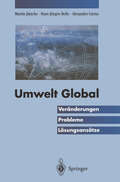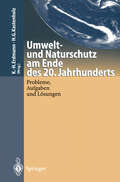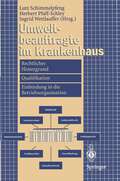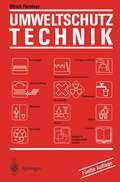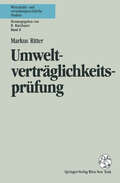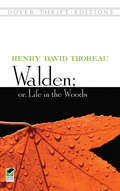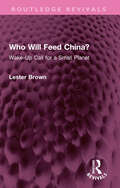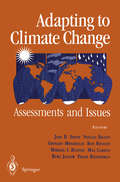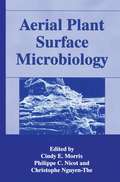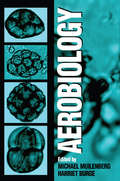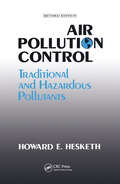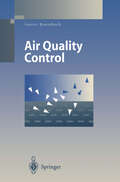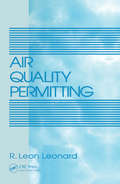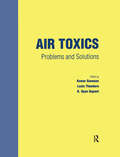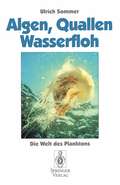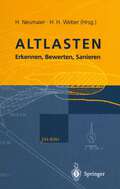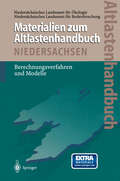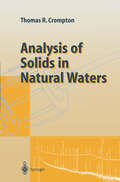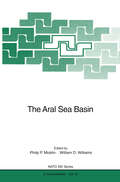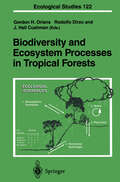- Table View
- List View
Umwelt Global: Veränderungen, Probleme, Lösungsansätze
by L. Wicke Martin Jänicke Hans-Jürgen Bolle Alexander CariusIn zunehmendem Maße wird deutlich, daß Veränderungen in der Umwelt über komplexe Rückkoppelungen in alle Bereiche der menschlichen Existenz einwirken. Naturwissenschaftliche Feststellungen müssen daher von sozialwissenschaftlichen Analysen begleitet werden mit dem Ziel, Handlungsansätze für Politik, Wirtschaft und Gesellschaft zu erarbeiten. Das vorliegende Buch, von kompetenten Wissenschaftlern zusammengestellt, erlaubt dem Leser, die Bedeutung langfristiger Umweltveränderungen und Herausforderungen für die Zukunft zu erkennen.
Umwelt-und Naturschutz am Ende des 20. Jahrhunderts: Probleme, Aufgaben und Lösungen
by Karl-Heinz Erdmann Hans G. KastenholzDie Lösungsmöglichkeiten der brennenden Probleme im Natur- und Umweltschutz stehen im Mittelpunkt des Buches. Der Leser erhält aus der Sicht unterschiedlicher wissenschaftlicher Disziplinen einen umfassenden Überblick über die Facetten und den aktuellen Stand des Natur- und Umweltschutzes.
Umweltbeauftragte im Krankenhaus: Rechtlicher Hintergrund, Qualifikation, Einbindung in die Betriebsorganisation
by Lutz Schimmelpfeng Herbert Pfaff-Schley Ingrid WettlaufferUmweltschutztechnik: Eine Einführung
by Ulrich FörstnerDieses einführende Buch erscheint mittlerweile in der fünften Auflage. Das umfangreiche überarbeitete Sachverzeichnis und der Festeinband machen es auch für die Arbeit in der täglichen Praxis sehr wertvoll.
Umweltverträglichkeitsprüfung und konzentriertes Genehmigungsverfahren nach dem UVP-G (Wirtschafts- und verwaltungsrechtliche Studien #8)
by Markus RitterDie Arbeit behandelt die 1993 in Österreich auf Verfassungs- und Gesetzesebene eingeführte Umweltverträglichkeitsprüfung (UVP) mitsamt Bürgerbeteiligung und Verfahrenskonzentration. Die zum Teil tiefgreifenden Änderungen werden durch eine vergleichende Bezugnahme auf das geltende Anlagenrecht eingehend dargestellt und analysiert. Ziel der Darstellung ist, allen mit dem UVP-G Konfrontierten die Möglichkeit zu geben, das Instrument der UVP vor dem Hintergrund seines öffentlichrechtlichen Umfeldes kennenzulernen und den beruflich damit Befaßten eine Richtschnur zur Interpretation der bisweilen äußerst komplizierten Bestimmungen dieses Gesetzes an die Hand zu geben.
Walden; Or, Life in the Woods
by Henry David ThoreauNature was a form of religion for naturalist, essayist, and early environmentalist Henry David Thoreau (1817–62). In communing with the natural world, he wished to "live deliberately, to front only the essential facts of life, and … learn what it had to teach." Toward that end Thoreau built a cabin in the spring of 1845 on the shores of Walden Pond — on land owned by Ralph Waldo Emerson — outside Concord, Massachusetts. There he observed nature, farmed, built fences, surveyed, and wrote in his journal.One product of his two-year sojourn was this book — a great classic of American letters. Interwoven with accounts of Thoreau's daily life (he received visitors and almost daily walked into Concord) are mediations on human existence, society, government, and other topics, expressed with wisdom and beauty of style.Walden offers abundant evidence of Thoreau's ability to begin with observations on a mundane incident or the minutiae of nature and then develop these observations into profound ruminations on the most fundamental human concerns. Credited with influencing Tolstoy, Gandhi, and other thinkers, the volume remains a masterpiece of philosophical reflection.A selection of the Common Core State Standards Initiative.
Who Will Feed China?: Wake-Up Call for a Small Planet (Routledge Revivals)
by Lester BrownOriginally published in 1995, but with enduring relevance in a time of global population growth and food insecurity, when it was first published, this book attracted much global attention, and criticism from Beijing. It argued that even as water becomes scarcer in a land where 80% of the grain crop is irrigated, as per-acre yield gains are erased by the loss of agricultural land to industrialization, and as food production stagnates, China still increases its population by the equivalent of a new Beijing each year. This book predicts that in an integrated world economy, China’s rising food prices will become the world’s rising food prices. China’s land scarcity will come everyone’s land scarcity and water scarcity in China will affect the entire world. China’s dependence on massive imports, like the collapse of the world’s fisheries, will be a wake-up call that we are colliding with the earth’s capacity to feed us. Over time, Janet Larsen argued, China’s leaders came to ‘acknowledge how Who Will Feed China? changed their thinking..’ As China’s wealth increases, so do the dietary demands of its population. The increasing middle classes demand more grain-intensive meat and farmed fish. The issue of who will feed China has not gone away.
Who Will Feed China?: Wake-Up Call for a Small Planet (Routledge Revivals)
by Lester BrownOriginally published in 1995, but with enduring relevance in a time of global population growth and food insecurity, when it was first published, this book attracted much global attention, and criticism from Beijing. It argued that even as water becomes scarcer in a land where 80% of the grain crop is irrigated, as per-acre yield gains are erased by the loss of agricultural land to industrialization, and as food production stagnates, China still increases its population by the equivalent of a new Beijing each year. This book predicts that in an integrated world economy, China’s rising food prices will become the world’s rising food prices. China’s land scarcity will come everyone’s land scarcity and water scarcity in China will affect the entire world. China’s dependence on massive imports, like the collapse of the world’s fisheries, will be a wake-up call that we are colliding with the earth’s capacity to feed us. Over time, Janet Larsen argued, China’s leaders came to ‘acknowledge how Who Will Feed China? changed their thinking..’ As China’s wealth increases, so do the dietary demands of its population. The increasing middle classes demand more grain-intensive meat and farmed fish. The issue of who will feed China has not gone away.
Adapting to Climate Change: An International Perspective
by Joel B. Smith Neeloo Bhatti Gennady V. Menzhulin Ron Benioff Max Campos Bubu Jallow Frank Rijsberman Mikhail I. Budyko R. K. DixonGlobal climate change is one of the most important environmental issues facing the world today. The United Nations Framework Convention on Climate Change (FCCC) acknowledges the potential for global climate change to have major effects on the world economy. The work of the Intergovernmental Panel on Cli mate Change (lPCC) is focused on evaluating the scientific data on climate change and analyzing the potential responses to it. One of the primary issues in the global climate change debate is how to adapt to any change that might occur. The process ofidentifying adaptation measures and evaluating their effectiveness is the focus of this book. In dealing with climate change adaptation, the sequence of events in conduct ing these types of analyses can be generalized as follows: • Develop scenarios for the possible range of climate change, • Assess the vulnerability of various sectors of the national economy and infrastructure to climate change, and • Identify and evaluate measures in each sector to adapt to the climate change It is this third step that is the subject of this book. In presenting this material, Chapter 1 gives an overview of the concept of climate change adaptation and the general principles guiding the conduct of analyses in this area. Chapters 2-7 give the results of evaluating climate change adaptation options in the agriculture, water resources, coastal resources, forest and ecosystems, fisheries, and human settlements sectors.
Aerial Plant Surface Microbiology
by Cindy E. Morris Philippe C. Nicot Christophe Nguyen-The''Informative, well-constructed, and readable...The contributors are leaders in their fields and what they have to say is worthwhile.'' --- SGM Quarterly, August 1998
Aerobiology
by Michael L. Muilenberg Harriet A. BurgeAerobiology is the study of airborne particles that have an impact on humans and other organisms. Every day, we are exposed to airborne particles, including "natural" particles such as pollen, bacteria, and fungi, and "unnatural" particles, such as asbestos fibers and noxious chemicals. Aerobiology highlights the current interests in this field, primarily the ecology and distribution of airborne particles and their effects on health.
Aerobiology
by Michael L. Muilenberg Harriet A. BurgeAerobiology is the study of airborne particles that have an impact on humans and other organisms. Every day, we are exposed to airborne particles, including "natural" particles such as pollen, bacteria, and fungi, and "unnatural" particles, such as asbestos fibers and noxious chemicals. Aerobiology highlights the current interests in this field, primarily the ecology and distribution of airborne particles and their effects on health.
Air Pollution Control: Traditional Hazardous Pollutants, Revised Edition
by Howard D. HeskethSince the first edition was printed in 1991, there have only been minor changes in air regulations. The opposing "trenches" used by environmental regulation proponents have deepened as each side increases their database. Agencies and environmental groups have backed off a little in issues such as bubble policies and enforcement time tables. This has made it extremely difficult for equipment vendors to anticipate industry requirements. Overall, the current market projections are not very favorable for the new equipment suppliers. In contrast, the service organizations are seeing increasing need for their help in areas such as dispersion modeling, troubleshooting and testing. Existing systems are being improved upon to keep them in operation. There remains a continuous need for up-to-date references and training materials to serve these needs, and it is for this purpose this revised edition is dedicated.
Air Pollution Control: Traditional Hazardous Pollutants, Revised Edition
by Howard D. HeskethSince the first edition was printed in 1991, there have only been minor changes in air regulations. The opposing "trenches" used by environmental regulation proponents have deepened as each side increases their database. Agencies and environmental groups have backed off a little in issues such as bubble policies and enforcement time tables. This has made it extremely difficult for equipment vendors to anticipate industry requirements. Overall, the current market projections are not very favorable for the new equipment suppliers. In contrast, the service organizations are seeing increasing need for their help in areas such as dispersion modeling, troubleshooting and testing. Existing systems are being improved upon to keep them in operation. There remains a continuous need for up-to-date references and training materials to serve these needs, and it is for this purpose this revised edition is dedicated.
Air Quality Control: Formation and Sources, Dispersion, Characteristics and Impact of Air Pollutants — Measuring Methods, Techniques for Reduction of Emissions and Regulations for Air Quality Control (Environmental Science and Engineering)
by G. BaumbachAir quality and air pollution control are tasks of international concern as, for one, air pollutants do not refrain from crossing borders and, for another, industrial plants and motor vehicles which emit air pollutants are in widespread use today. In a number of the world's expanding cities smog situations are a frequent occurrence due to the number and emission-intensity of air pollution sources. Polluted air causes annoy ances and can, when it occurs in high concentrations in these cities, constitute a seri ous health hazard. How important clean air is to life becomes apparent when consid ering the fact that humans can do without food for up to 40 days, without air, how ever, only a few minutes. The first step towards improving the air quality situation is the awareness that a sound environment is as much to be aspired for as the development of new tech nologies improving the standard of living. Technical progress should be judged es pecially by how environmentally benign, clean and noiseless its products are. Of these elements, clean air is of special concern to me. I hope that this book will awaken more interest in this matter and that it will lead to new impulses. Due to the increasing complexity of today's machinery and industrial processes science and technology can no longer do without highly specialized design engineers and opera tors. Environmental processes, however, are highly interdependent and interlinked.
Air Quality Permitting
by R. Leon LeonardThis practical book covers all of the fundamentals for obtaining air quality permits for new sources of air pollutant emissions and Title V operating permits for operating sources. Written for facility environmental managers, consultants, and air quality regulatory staff, Air Quality Permitting provides a thorough discussion on the strategies of successfully permitting a facility.
Air Quality Permitting
by R. Leon LeonardThis practical book covers all of the fundamentals for obtaining air quality permits for new sources of air pollutant emissions and Title V operating permits for operating sources. Written for facility environmental managers, consultants, and air quality regulatory staff, Air Quality Permitting provides a thorough discussion on the strategies of successfully permitting a facility.
Air Toxics: Problems and Solutions
by Kumar GanesanThis timely new workbook is the result of a year-long effort by a group of university professors who first met at Montana Tech during the summer of 1994 for a college faculty workshop. The workshop was funded by the National Science Foundation's support for those faculty developing courses in the newly emerging field of air toxics. Part I of the book contains over 100 problems dealing with a variety of topics in this area. Part II provides detailed solutions. The problems and solutions provided will become a useful resource for the training of engineers and scientists who are or soon will be working in the field.
Air Toxics: Problems and Solutions
by Kumar GanesanThis timely new workbook is the result of a year-long effort by a group of university professors who first met at Montana Tech during the summer of 1994 for a college faculty workshop. The workshop was funded by the National Science Foundation's support for those faculty developing courses in the newly emerging field of air toxics. Part I of the book contains over 100 problems dealing with a variety of topics in this area. Part II provides detailed solutions. The problems and solutions provided will become a useful resource for the training of engineers and scientists who are or soon will be working in the field.
Algen, Quallen, Wasserfloh: Die Welt des Planktons
by Ulrich SommerMilliarden winziger Krebse und Larven, Quallen und Algen, Bakterien und Pilze leben in Seen und Meeren. Das Buch führt in ihre faszinierende Formenvielfalt ein und zeigt, welche Rolle sie im Ökosystem der Gewässer spielen. Zahlreiche Beispiele, Abbildungen und Schemata verdeutlichen die komplexe Lebensgemeinschaft in dieser oft mikroskopisch kleinen Welt.
Altlasten: Erkennen, Bewerten, Sanieren
by W. Fresenius G. Mattheß H. Müller-Kirchenbauer W. D. Sondermann K. Storp E. WeßlingEin in Wissenschaft und Praxis der Sanierung von Altlasten erfahrenes Herausgeber- und Autorenteam gibt in diesem Standardwerk einen umfassenden Überblick über die Sanierungstechnologien. Die kritische Darstellung orientiert sich am Stand der Technik und am ökonomisch Machbaren. Alle Beiträge wurden für die dritte Auflage komplett überarbeitet, aktuelle Themen neu aufgenommen.
Altlastenhandbuch des Landes Niedersachsen Materialienband: Berechnungsverfahren und Modelle
by Wolfgang Kinzelbach Axel Voss Randolf Rausch Jean-Pierre Sauty Wen-Hsing Chiang C. Cordes S.Z. FangAnwendungsbezogener Einstieg in die komplexe numerische Modellierung im Altlastenbereich.Zusätzliche CD-ROM mit Programmen für die numerische Modellierung, Beispieldaten und editierbaren Quellen.
Analysis of Solids in Natural Waters
by Thomas R. CromptonAs only a few books have been published on the matter of toxic materials in water it occurred to the author that a comprehensive volume dealing with all aspects of this subject was overdue. In this book there is a complete discussion of world literature on the determination of metals, non-metals, organic substances, organometallic com pounds, together with organic carbon parameters and radioactive elements in river, stream, lake and pond sediments, marine and estuarine sediments, river and sea fish, crustacea and molluscs, phytoplankton and sea and river weeds. Much very detailed work has been carried out on this subject over the past 20 years and a review of this work is timely in view of the increasing interest to chemists, environmentalists and others concerned with the quality of our environ ment. The presence of organic and inorganic substances in river and oceanic sediments is due in part to man-made pollution, and monitoring the levels of these substances in sediment and sediment core samples provides an indication of the time dependence of element concentration over large time spans. Contamination of sediments is found not only in rivers but also in estuarine sediments and sometimes in oceanic sedi ments, and this sediment analysis provides a means of tracking elements from their sources through the ecosystem.
The Aral Sea Basin (Nato Science Partnership Subseries: 2 #12)
by Philip P. Micklin and William D. WilliamsThe Aral Sea Basin, which is located in the central Asian part of the former Soviet Union, is undergoing dramatically rapid and intense environmental change. Pervasive human misuse and overuse of its water, land, and other critical natural resources have led to severe degradation of key ecological systems. This book analyses the environmental, human and economic problems that have arisen and presents recommendations for future research needs. Primary focus is on the drying of the Aral Sea, but related issues of diminished river flow, land and water pollution, and degradation, ecosystem deterioration, and adverse effects on humans are also examined.
Biodiversity and Ecosystem Processes in Tropical Forests (Ecological Studies #122)
by Gordon H. Orians Rodolfo Dirzo J. Hall CushmanAlthough biologists have directed much attention to estimating the extent and causes of species losses, the consequences for ecosystem functioning have been little studied. This book examines the impact of biodiversity on ecosystem processes in tropical forests - one of the most species-rich and at the same time most endangered ecosystems on earth. It covers the relationships between biodiversity and primary production, secondary production, biogeochemical cycles, soil processes, plant life forms, responses to disturbance, and resistance to invasion. The analyses focus on the key ecological interfaces where the loss of keystone species is most likely to influence the rate and stability of ecosystem processes.
